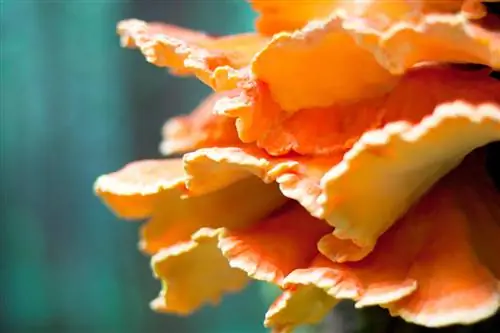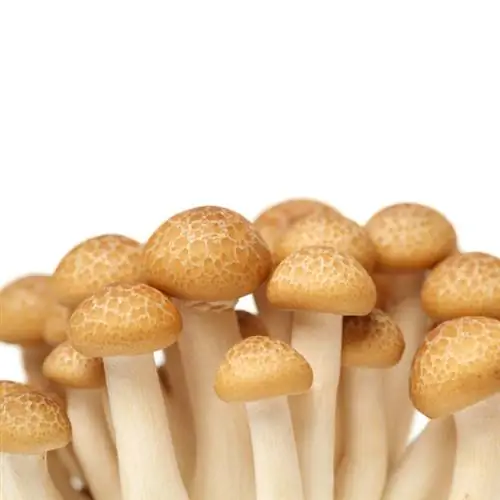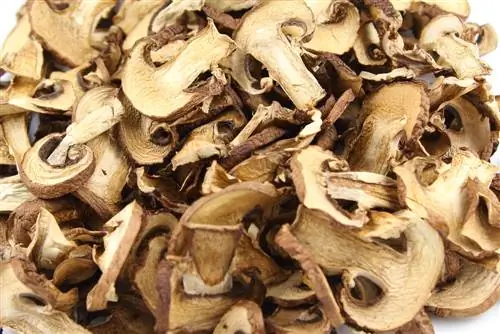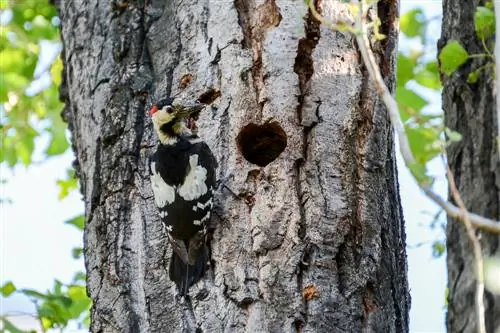- Author admin [email protected].
- Public 2023-12-16 16:46.
- Last modified 2025-01-23 11:19.
Various tree fungi boast striking, orange fruiting bodies. You can find out which mushroom species have chosen this color here. Tried-and-tested tips explain why you should better remove orange fungi on tree trunks.

Which orange mushrooms grow on the tree trunk?
Common orange mushrooms on the tree trunk areSulfur PorlingandLack Porling Furthermore, these orange mushrooms colonize a tree: fire fungus, tinder fungus, striated layer fungus, golden fur -Schüppling and Shaggy Schillerporling. Remove the orange fruiting bodies to prevent fungal spores from spreading to other trees.
Are orange fungi on tree trunks harmful to the tree?
Orange fungi on tree trunks areharmful because these tree fungi cause brown rot. The fungal spores penetrate through the smallest cuts and gradually decompose the heartwood of living host trees. In the final stage of fungal infestation, breakage and stability are massively threatened.
Because orange fungi initially spare the pathways in the sapwood, the affected tree can survive the disease for many years. Over time, brown rot hollows out the inside of the tree trunk, causing it to collapse.
Which orange mushrooms grow on the tree trunk?
Common orange mushrooms on the tree trunk areSulfur Porling(Laetiporus sulphureus) andLackporling (Ganoderma lucidum). Both types of fungi make themselves unpopular as weakness parasites on oak trees and in mixed deciduous forests. The yellow to orange fruiting bodies sprout more rarely on conifers. These are other wood-dwelling orange mushrooms:
- Fire sponge (Phellinus) on oaks, robinias, willows, poplars.
- Tinder fungus (Fomes fomentarius) on copper beeches, birches, poplars.
- Harrowed layer fungus (Stereum hirsutum) prefers to grow on freshly felled oak trunks and coniferous trees.
- Gold-fur fledgling (Pholiota aurivella), preferably on beeches.
- Shaggy Schillerporling (Inonotus hispidus) on ash, walnut and apple trees.
Should I remove orange mushrooms from tree trunk?
You shouldremove orange mushrooms from the tree trunk so that the fungal pathogens do not spread any further. It is best to cut branches with individual, orange fruiting bodies back into he althy wood, which slows down the spread of fungal infection inside the tree. Remove orange fungi on the tree trunk with a knife and dispose of the fruiting bodies in the trash. The tree should then be inspected to ensure it is roadworthy. If there are legitimate doubts about its breaking strength and stability, it is advisable to clear the tree including the rootstock.
Tip
The largest living thing in the world is a tree fungus
If you admire a honey mushroom (Armillaria mellea) on a tree trunk, you are coming face to face with the relative of the largest living creature in the world. The superlative tree fungus grows in Oregon over an area of a breathtaking 9 square kilometers (equivalent to 1200 football fields). With this size, the mushroom giant easily tops every blue whale and sequoia tree. Scientists have determined a biblical age of 2,400 years for the giant hornworm.






